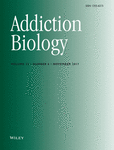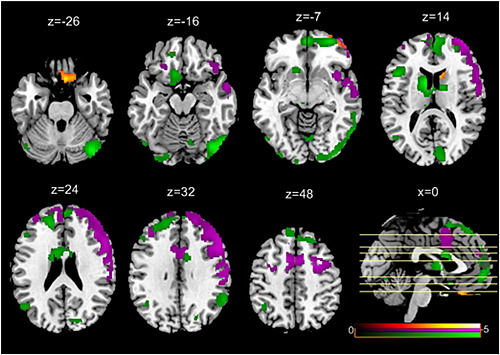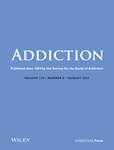Journal list menu
Export Citations
Download PDFs
Issue Information
Human Genetics
An association study revealed substantial effects of dominance, epistasis and substance dependence co-morbidity on alcohol dependence symptom count
- Pages: 1475-1485
- First Published: 05 May 2016
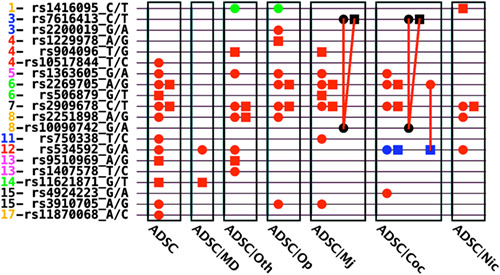
We conducted a genome-wide association studies of alcohol dependence symptom count with a full genetic model considering additive, dominance, epistasis and their interactions with ethnicity, as well as conditions of co-morbid substance dependence. Twenty quantitative trait SNPs (QTSs) were identified, including four previously reported genes such as ADH1C, four novel genes, two non-coding RNAs and two epistasis loci. The detected QTSs contributed to about 20 percent of total heritability, in which dominance and epistasis effects accounted for over 50 percent.
Computational Studies
The HPA axis and ethanol: a synthesis of mathematical modelling and experimental observations
- Pages: 1486-1500
- First Published: 18 May 2016
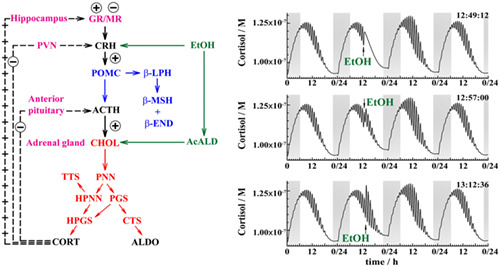
A stoichiometric model is developed to succinctly describe ethanol effects on neurochemical transformations underlying the hypothalamic-pituitary-adrenal (HPA) axis. This enables the investigation of ethanol effects on HPA axis activity with high temporal resolution, where experimental data are scarce. Mathematical modelling shows that ethanol effects on HPA axis activity are complex and dependent on ethanol dose, timing and administration strategy; it enables us to shed light on so far inconclusive experimental results and may help to design further experiments.
Essential values of cocaine and non-drug alternatives predict the choice between them
- Pages: 1501-1514
- First Published: 14 September 2016
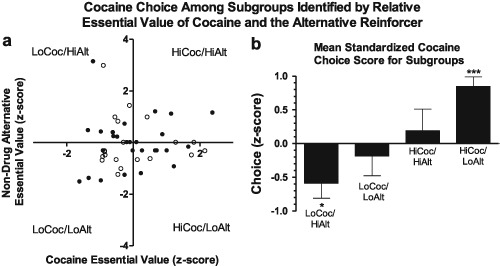
Individual differences in how rats valued cocaine or a non-drug alternative (food or saccharin) predicted subsequent choice behavior in an animal model of addiction. Rats that placed either high value on cocaine or low value on the non-drug alternative were most likely to prefer cocaine. These results are consistent with the notion that addiction involves both overvaluation of drug rewards and undervaluation of non-drug alternatives.
Human Studies
Effects of naltrexone on alcohol self-administration and craving: meta-analysis of human laboratory studies
- Pages: 1515-1527
- First Published: 14 July 2016

This meta-analysis examined the aggregate effects of naltrexone versus placebo on alcohol self-administration and craving across human laboratory studies. Meta-analyses of self-administration (N = 490) and craving (N = 748) confirmed that naltrexone reduces laboratory consumption and acute craving relative to placebo. These results provide further evidence as to potential treatment mechanisms, also establishing effect sizes to inform future human laboratory trials.
Reward and relief dimensions of temptation to drink: construct validity and role in predicting differential benefit from acamprosate and naltrexone
- Pages: 1528-1539
- First Published: 02 August 2016
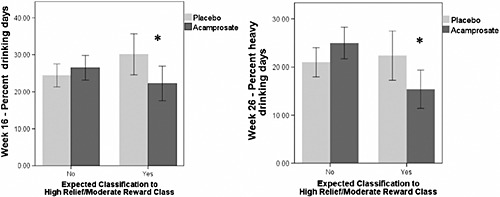
Study findings suggest that 10 items from the Temptation Scale of the Alcohol Abstinence Self-Efficacy Scale can be used to identify alcohol use disorder subtypes characterized by distinct pre-treatment patterns of reward and relief temptation to drink tendencies. Moreover, results indicated that acamprosate was particularly effective among a subgroup of clients with higher relief temptation than reward temptation.
The gut in the brain: the effects of bariatric surgery on alcohol consumption
- Pages: 1540-1553
- First Published: 31 August 2016
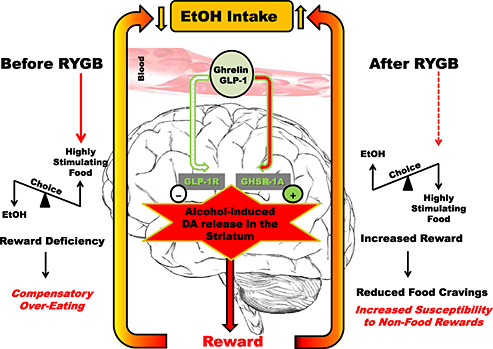
Recent rodent and human studies indicate that bariatric surgery, especially gastric bypass, may lead to the possible development of alcohol use disorder. Preliminary translational studies attribute changes in alcohol metabolism/pharmacokinetics resulting from bariatric surgery to be the most likely explanation. However, recent research reveals that alterations in brain reward processing may play an important role as well.
A dose–response estimate for acute alcohol use and risk of suicide attempt
- Pages: 1554-1561
- First Published: 10 August 2016
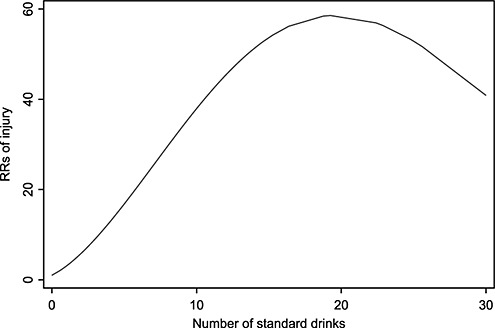
Using data from a large and representative sample of patients from several countries and regions of the world, we found that every drink increased the risk of a suicide attempt by 30 percent, and 35 percent of all attempts were attributable to acute alcohol; even one to two drinks were associated with a sizable increase in the risk, and a dose–response was found for the relation between acute drinking and the risk of a suicide attempt up to 20 drinks.
Human Neuroimaging Studies
Neural response to alcohol taste cues in youth: effects of the OPRM1 gene
- Pages: 1562-1575
- First Published: 05 September 2016
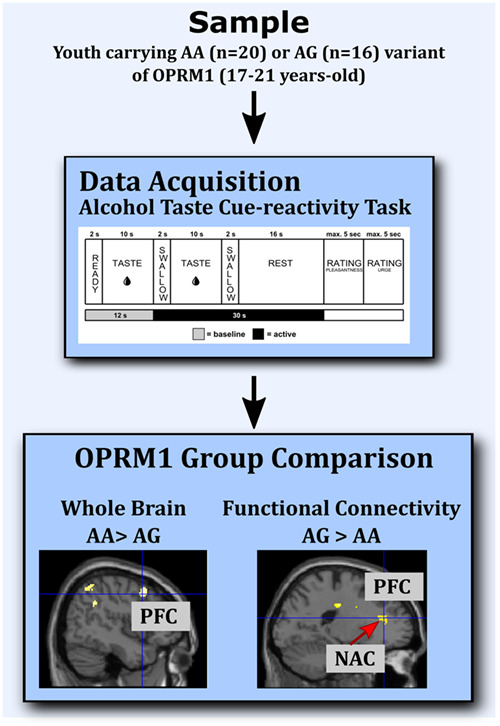
In a young sample, we demonstrated reduced prefrontal activation and greater connectivity from the ventral-striatum to frontal regions, in the AG vs AA-variant of the OPRM1 gene (rs1799971) for alcohol > water-taste trials. These results indicate that adolescents carrying the G-allele may be more vulnerable for the alcohol to hijack the reward system in the absence of frontal control to regulate craving.
Acute naltrexone does not remediate fronto-striatal disturbances in alcoholic and alcoholic polysubstance-dependent populations during a monetary incentive delay task
- Pages: 1576-1589
- First Published: 06 September 2016
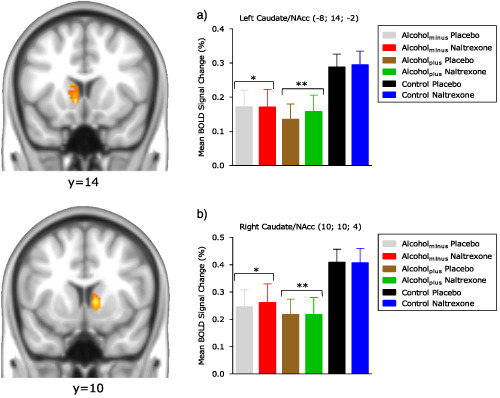
Opioid disturbances within dopamine fronto-striatal reward circuitry may confer an ongoing risk for relapse to drug rewards if there is a diminished incentive value of, and motivation to procure, non-drug rewards. Here, we show that acute naltrexone treatment does not remediate disturbances in fronto-striatal regions during non-drug reward anticipation in long-term abstinent alcoholic and polysubstance-dependent groups.
White matter integrity between left basal ganglia and left prefrontal cortex is compromised in gambling disorder
- Pages: 1590-1600
- First Published: 09 September 2016
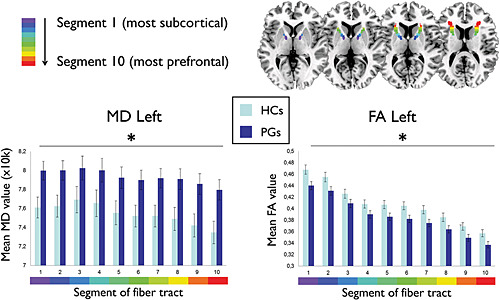
In this multi-modal study, we investigated cognitive flexibility, associated brain activity and white matter integrity in gambling disorder. We found decreased corticostriatal white matter integrity in pathological gamblers in a tract specifically essential for cognitive flexibility. We argue that this may be an underlying risk factor for gambling disorder, which may extend to addiction in general.
Evidence for GABA-A receptor dysregulation in gambling disorder: correlation with impulsivity
- Pages: 1601-1609
- First Published: 13 October 2016
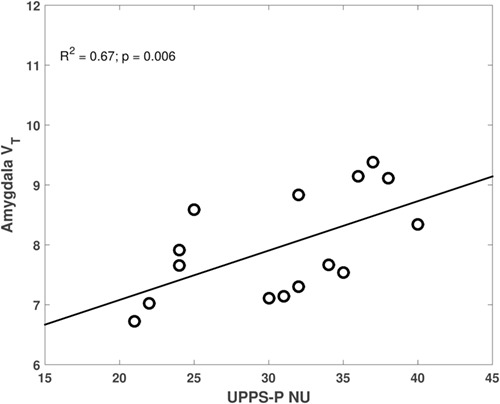
We used [11C]Ro15–4513 PET to assess GABA-a5 receptor availability in gambling disorder (GD) and impulsivity. We found significantly higher [11C]Ro15–4513 total distribution volume (VT) in the right hippocampus in GD compared with healthy volunteers. We found higher levels of The ‘Negative Urgency’ construct of impulsivity in GD that positively associated with higher [11C]Ro15–4513 VT in the amygdala in the GD group; no such significant correlations were evident in the healthy volunteers group.
Impaired decision-making and impulse control in Internet gaming addicts: evidence from the comparison with recreational Internet game users
- Pages: 1610-1621
- First Published: 30 September 2016
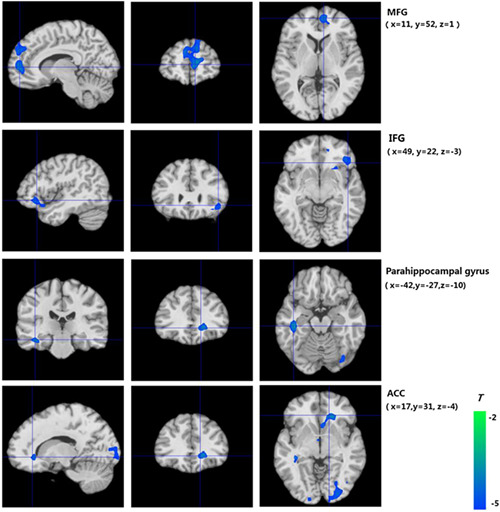
During the delay discounting and probabilistic discounting tasks, the Internet gaming disorder is more impulsive and shows lower brain activation in the parahippocampal gyrus, anterior cingulate cortex, inferior frontal gyrus, and medial frontal gyrus than recreational Internet gaming users. The results suggest that the recreational Internet gaming users are capable to inhibit impulse due to additional cognitive endeavor, and the Internet gaming disorder has deficit indecision-making and impulsive control. The brain regions are involved in decision-making and cognitive control and may be a key mechanism preventing recreational game players from the risk of developing addiction.
A hypo-status in drug-dependent brain revealed by multi-modal MRI
- Pages: 1622-1631
- First Published: 22 September 2016
Clinical Study
A clinical trial with combined transcranial direct current stimulation and alcohol approach bias retraining
- Pages: 1632-1640
- First Published: 27 October 2016
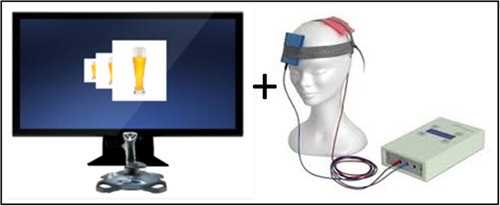
This study investigated whether 2 mA of transcranial direct current stimulation (tDCS) on the dorsolateral prefrontal cortex could enhance effects of four sessions of cognitive bias modification (CBM). No strong evidence for a specific enhancement effect of tDCS on CBM was found. In a post-hoc analysis, tDCS combined with CBM did show a promising trend on treatment outcome.
Preclinical Studies
Nucleus incertus corticotrophin-releasing factor 1 receptor signalling regulates alcohol seeking in rats
- Pages: 1641-1654
- First Published: 20 July 2016
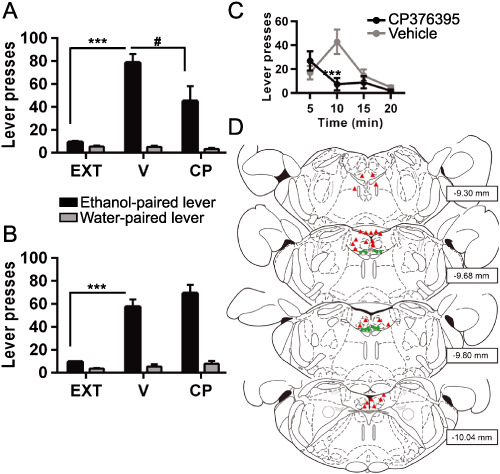
Bilateral injections into the rat nucleus incertus (NI) of CP376395 (500 ng/0.25 µl) attenuated yohimbine-induced reinstatement of alcohol seeking, whereas astressin-2B (200 ng/0.25 µl) had no significant effect. CRF-receptor 1, but not CRF-receptor 2, mRNA was upregulated in the NI following chronic ethanol intake. Corticotrophin-releasing factor (CRF) mRNA is expressed within the rat NI; CRF-containing neurons were confirmed by immunohistochemistry. NI neurons apparently contribute to alcohol seeking, via CRF-receptor 1 signaling. Chronic ethanol intake causes neuroadaptive changes in NI CRF and relaxin-3 systems.
OPRM1 genotype interacts with serotonin system dysfunction to predict alcohol-heightened aggression in primates
- Pages: 1655-1664
- First Published: 03 August 2016
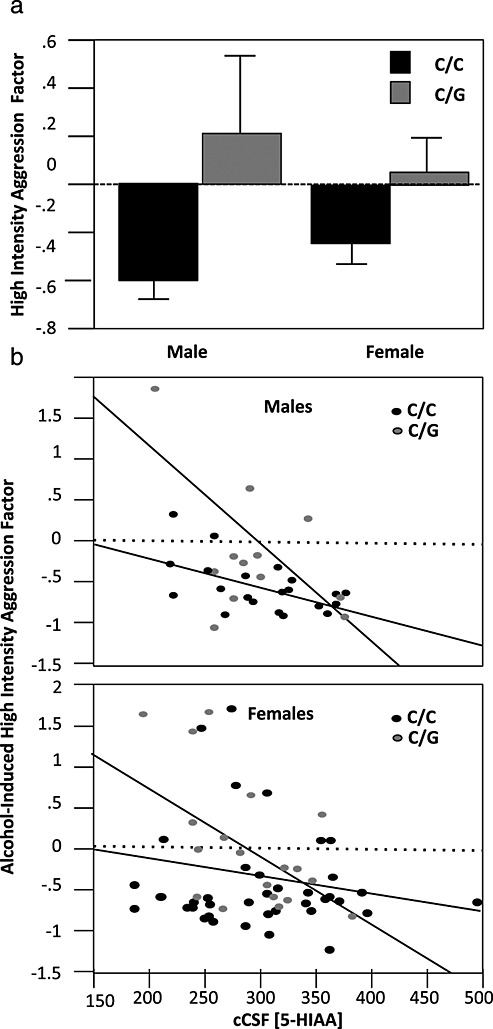
The rhesus macaque has been repeatedly shown to be useful for modeling genetic effects and G × E interactions that translate to the human condition. Results from the present study suggest the following: (1) that individuals who carry a variant in the OPRM1 gene experience more alcohol-induced stimulation are more likely react aggressively to provocation while intoxicated; (2) that subjects that exhibit a trait-like aggression marker (low CSF 5-HIAA) may be particularly prone to aggression during periods of intoxication if they are also carriers of the OPRM1 variant allele. By extension, these data suggest that the same factors that give rise to early, uncontrolled alcohol intake (impaired impulse control and increased alcohol-mediated reward) may also be risk factors for alcohol-induced aggressive responding. As OPRM1 genotype predicts clinical outcome following naltrexone treatment in alcohol dependent populations, these results may further suggest that naltrexone treatment may have promise for preventing or reducing alcohol-associated violence in selected patient populations.
Intravenous self-administration of alcohol in rats—problems with translation to humans
- Pages: 1665-1681
- First Published: 02 August 2016
Intravenous self-administration (IVSA) of alcohol has been investigated across species. This systematic review shows that the amount of alcohol self-administered by rats is about 20–25 mg/kg/h, about 50- to 100-fold lower than by NHP or mice. Evidence to support such IVSA as well as potential mechanisms underlying such self-administration is discussed. The minute amounts of alcohol shown to maintain IVSA in rats challenge the relationship between their blood alcohol levels and the reinforcing effects of alcohol.
Prolonged withdrawal from cocaine self-administration affects prefrontal cortex- and basolateral amygdala–nucleus accumbens core circuits but not accumbens GABAergic local interneurons
- Pages: 1682-1694
- First Published: 25 July 2016
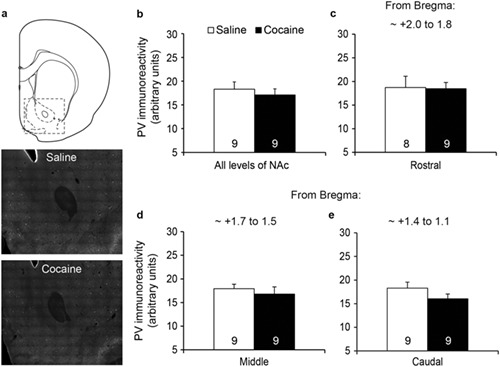
We examined aspects of GABA transmission in nucleus accumbens (NAc) core after incubation of cocaine craving. Activity-dependent interneuron markers (e.g. parvalbumin) were unchanged, but local field potential recordings revealed differential adaptations in prefrontal cortex-NAc core and basolateral amygdala-NAc core circuits, some potentially involving GABA. Combined with other findings, our results suggest more pronounced changes in glutamate than GABA during incubation.
Hypocretin/orexin knock-out mice display disrupted behavioral and dopamine responses to cocaine
- Pages: 1695-1705
- First Published: 02 August 2016
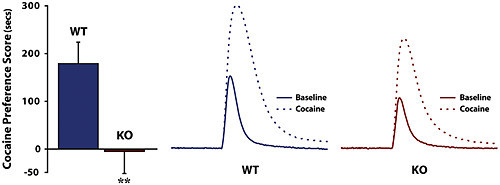
The hypocretin/orexin system has been posited to influence reward and reinforcement processes through actions on the mesolimbic dopamine system. Using conditioned place preference, microdialysis, and fast-scan cyclic voltammetry, we demonstrate that hypocretin knockout mice fail to develop conditioned place preference for cocaine and display reduced dopamine release under baseline conditions and in response to cocaine.
Caffeine-mediated BDNF release regulates long-term synaptic plasticity through activation of IRS2 signaling
- Pages: 1706-1718
- First Published: 25 July 2016
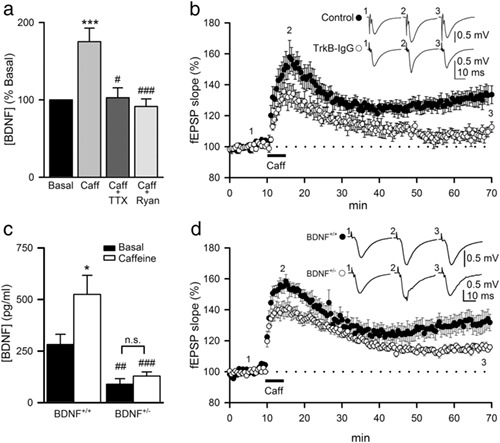
Caffeine, a stimulant that enhances cognitive function, is the most widely consumed behaviorally active substance in the world. Here, we show that caffeine, at moderate doses of human consumption, induces an NMDA receptor-independent form of long-term potentiation and increases calcium-dependent brain-derived neurotrophic factor secretion, which is necessary for long-term potentiation maintenance through a TrkB-mediated process and activation of IRS2/PI3K/Akt signaling.
The infralimbic and prelimbic cortices contribute to the inhibitory control of cocaine-seeking behavior during a discriminative stimulus task in rats
- Pages: 1719-1730
- First Published: 22 August 2016
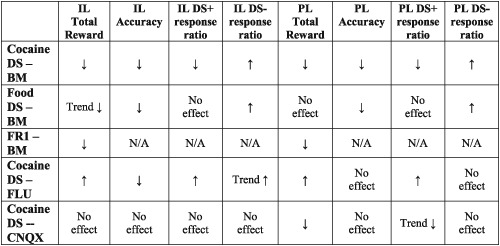
In a discriminative stimulus (DS) cocaine self-administration task, inactivation of the infralimbic or prelimbic cortex decreased performance accuracy and disinhibited behavioral responding. Inactivation of either structure decreased total infusions during both a DS task and an FR1 task. Combined with additional pharmacological manipulations, these results suggest that both regions contribute to the inhibitory control of drug-seeking behavior during a DS task.
Dissociative role for dorsal hippocampus in mediating heroin self-administration and relapse through CDK5 and RhoB signaling revealed by proteomic analysis
- Pages: 1731-1742
- First Published: 22 August 2016
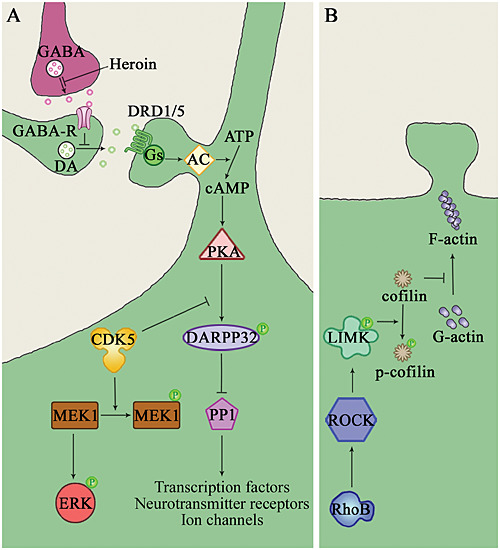
Cyclin-dependent kinase 5 (CDK5) and ras homolog family member B (RhoB) were up-regulated in the dorsal hippocampus (DH) of rats with a history of extended access to heroin. CDK5 signaling acts as a homeostatic compensatory mechanism to limit heroin-taking behavior, whereas RhoB signaling is required for the retrieval of addiction memory. The present study suggests that the DH can exert dissociative effects on heroin addiction through CDK5 and RhoB signaling.
Nicotine self-administration remodels perineuronal nets in ventral tegmental area and orbitofrontal cortex in adult male rats
- Pages: 1743-1755
- First Published: 22 August 2016
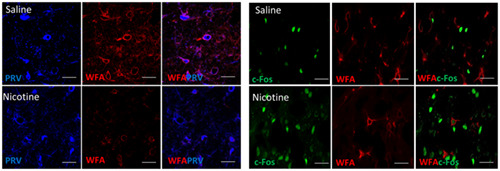
Nicotine self-administration remodeled perineuronal nets surrounding GABA interneurons in the ventral tegmental area and the orbitofrontal cortex, suggesting a new possible molecular target where nicotine-induced neuroplasticity takes place. Perineuronal net manipulations may prevent or reverse the different stages of tobacco addiction.
Morphine treatment enhances glutamatergic input onto neurons of the nucleus accumbens via both disinhibitory and stimulating effect
- Pages: 1756-1767
- First Published: 22 August 2016
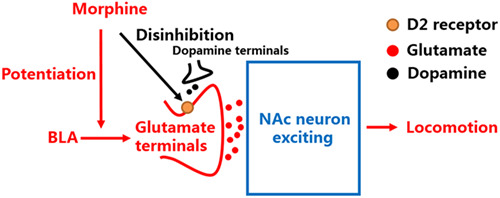
The NAc is an important site where morphine treatment produces its reinforcing effect on reward. We found that morphine treatment removes the inhibitory effect of DA on glutamatergic input onto NAc and potentiates glutamatergic input from BLA to NAc. Blockade of glutamatergic transmission in NAc or ablation of projection from BLA to NAc decreases morphine treatment-induced increase in locomotor activity.
Emotional, physical and sexual abuse are associated with a heightened limbic response to cocaine cues
- Pages: 1768-1777
- First Published: 22 September 2016
Chronic exposure to cannabinoids during adolescence causes long-lasting behavioral deficits in adult mice
- Pages: 1778-1789
- First Published: 31 August 2016

Adolescent mice were subjected daily to WIN55212.2, then left undisturbed, and finally evaluated by behavioral testing at adulthood. Mice that received the drug during adolescence showed memory impairment, higher endocannabinoid levels and altered Rgs7 expression in adulthood, establishing a potential link to epigenetic changes.
Executive control network connectivity strength protects against relapse to cocaine use
- Pages: 1790-1801
- First Published: 07 September 2016
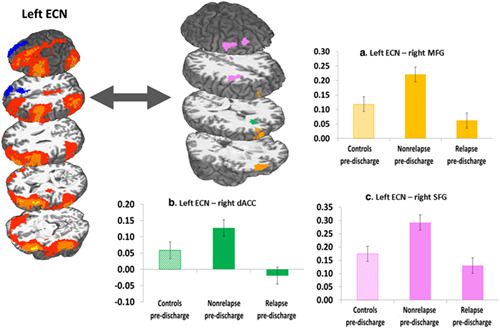
Resting state connectivity was examined in 45 individuals immediately prior to discharge from treatment for cocaine dependence. Connectivity strength within the executive control network and between the executive control network and salience network was found to protect against relapse 30 days post-treatment. Effects may reflect a greater capacity to engage executive control processes when faced with opportunities to use cocaine.
Behavioral and transcriptional patterns of protracted opioid self-administration in mice
- Pages: 1802-1816
- First Published: 31 August 2016
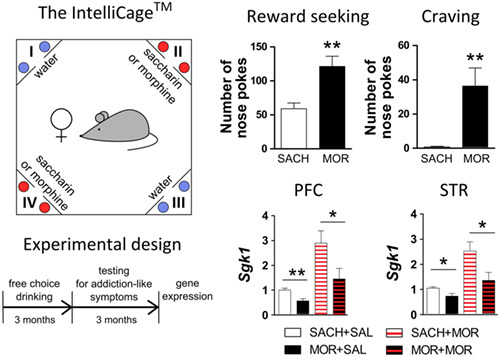
The present study analyzes the phenotypic and molecular effects of protracted voluntary oral morphine or saccharin intake in mice. Animals self-administering morphine showed complex addiction-related behavioral pattern associated with long-lasting alterations in several groups of transcripts, including glucocorticoid receptor-dependent, circadian and insulin signaling pathway genes as revealed by the global gene expression in the striatum and prefrontal cortex.
Impairment of opiate-mediated behaviors by the selective TRPV1 antagonist SB366791
- Pages: 1817-1828
- First Published: 11 October 2016
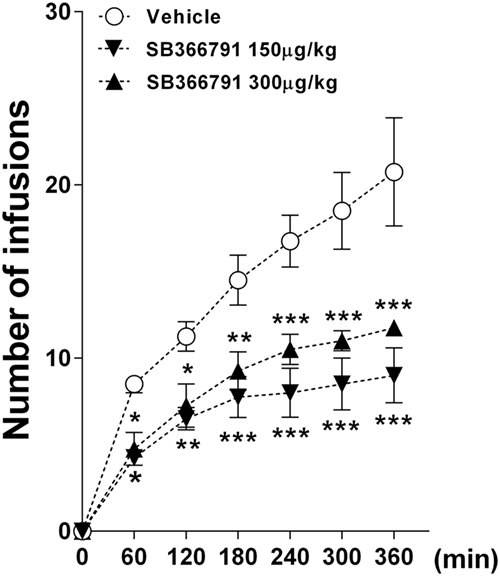
We found that treatment with a selective TRPV1 antagonist, SB366791, significantly decreased morphine self-administration on a fixed-ratio 1 schedule or a progressive ratio schedule of reinforcement. In addition, treatment with another selective TRPV1 antagonist, AMG9810, not only significantly prevented morphine self-administration but also prevented morphine-induced c-fos expression in the nucleus accumbens. Furthermore, administration of SB366791 decreased an anxiolytic-like effect during the morphine abstinence period. Moreover, treatment with SB366791 significantly decreased morphine-priming reinstatement.
Gender differences in the inflammatory cytokine and chemokine profiles induced by binge ethanol drinking in adolescence
- Pages: 1829-1841
- First Published: 04 October 2016
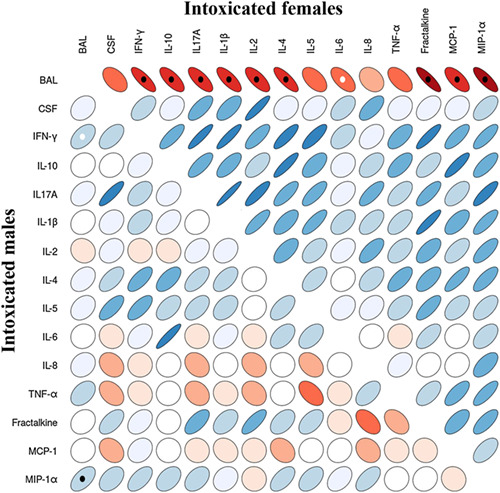
Female adolescents are more vulnerable than male adolescents to the inflammatory effects of binge alcohol drinking. Circulating cytokines and chemokines might serve as clinical biomarkers of neuroinflammation. The TLR4 response is an important target of the ethanol-induced immune and neuroimmune response in adolescence. This figure shows a negative correlation (Pearson's coefficient) between cytokines/chemokines and blood alcohol levels in intoxicated females (red ellipses) and positive correlation in intoxicated males (blue ellipses). Black and white points denote significance and tendency, respectively.
Cocaine-induced synaptic structural modification is differentially regulated by dopamine D1 and D3 receptors-mediated signaling pathways
- Pages: 1842-1855
- First Published: 12 October 2016
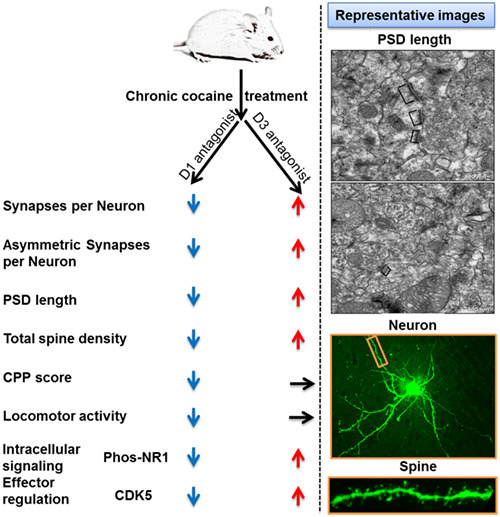
By using the unbiased quantitative stereological physical dissector method, we provide direct electron microscopy evidence that dopamine D1 and D3 receptors reciprocally regulate the ultra-structural changes of synapses following chronic exposure to cocaine. In addition, our data suggest that D1 and D3 receptors may regulate cocaine-induced ultra-structural changes and behavior responses by impact on structural plasticity and signaling transduction.
Region specific activation of the AKT and mTORC1 pathway in response to excessive alcohol intake in rodents
- Pages: 1856-1869
- First Published: 20 October 2016
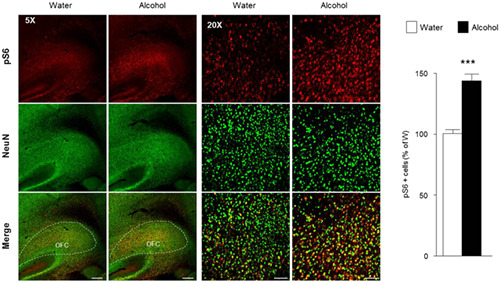
Excessive alcohol intake, but not moderate alcohol or sucrose consumption, produces a brain region selective activation of the AKT/mTORC1 pathway in the nucleus accumbens shell and the orbitofrontal cortex of rodents, which is likely to contribute to local molecular mechanisms that underlie the development and maintenance of alcohol drinking behavior.
Increase of KCC2 in hippocampal synaptic plasticity disturbances after perinatal ethanol exposure
- Pages: 1870-1882
- First Published: 25 October 2016
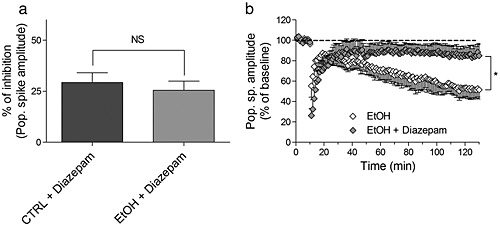
In rat CA1 pyramidal cell, ethanol exposure during brain development disturbs long-term synaptic plasticity via an increase in the role of KCC2 co-transporter. Bumetanide, a dose-dependent blocker of the two chloride cotransporters NKCC1 and KCC2 help restoring new equilibrium between the roles of these transporters.
Association of contextual cues with morphine reward increases neural and synaptic plasticity in the ventral hippocampus of rats
- Pages: 1883-1894
- First Published: 22 September 2017
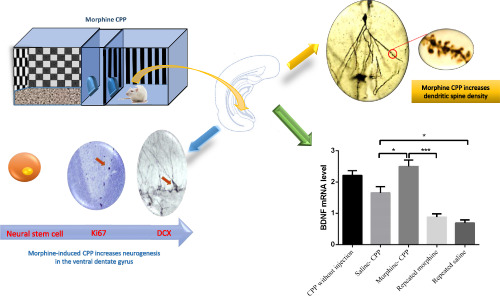
Increased number of Ki67 and DCX positive neurons in the ventral dentate gyrus was found in the morphine-induced conditioned place preference. Dendritic spine density of the dentate gyrus granule cells and CA1 pyramidal neurons were significantly increased in CPP-morphine group. BDNF and TrkB mRNA levels in the ventral hippocampus of CPP-morphine group were increased. Ki67, DCX positive cells, and spine density were significantly correlated with conditioned place preference scores.




